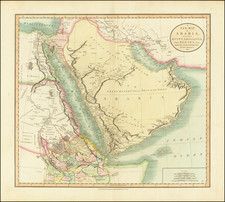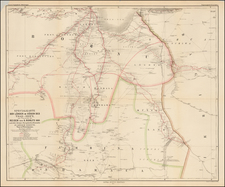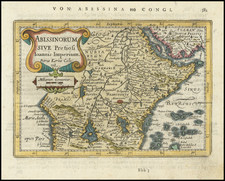Mapping The Boundary Between Victoria Nyanza to Mt. Kilimanjaro
The map titled "Victoria Nyanza to Mt. Kilimanjaro" provides a meticulously detailed representation of the region between these two iconic landmarks in East Africa. Published in the esteemed Royal Geographical Journal in 1907, it bears the fruits of the laborious surveys conducted between 1904 and 1906 by both the British and German sections of the Anglo-German Boundary Commission.
The map offers an in-depth portrayal of topographical features. Mountains, key elements of the region's topography, are shaded in a rich brown, providing visual emphasis. The blue rivers snake their way across the terrain, while occasional valleys, lakes, and other geographical markers further enrich the representation. Aesthetically partitioned, the map illustrates the region from Lake Magadi to the west on the top half, and from Lake Magadi to the east on the bottom.
One of the standout features is the comprehensive inset "Chart of Triangulation from Victoria Nyanza to Mt. Kilimanjaro". This chart showcases roughly 60 triangulation stations from which observations were made. The schematic point-to-point depiction of the triangulations offers invaluable insight into the survey methodology.
Historical Context and the Anglo-German Boundary Commission
At the turn of the 20th century, colonial ambitions of European powers in Africa were at their zenith. This scramble for Africa led to tensions and territorial overlaps. To avoid military confrontations, diplomatic solutions in the form of boundary delimitations were sought. The Anglo-German Boundary Commission was birthed out of this need.
Activities and Surveys: The Commission was tasked with demarcating boundaries in East Africa, primarily between British-held territories and German East Africa (present-day Tanzania). Over the span of three years (1904-1906), the commission members, armed with the latest survey equipment and techniques, embarked on a methodical journey of mapping the region. Triangulation, a method involving the measurement of triangles, was predominantly employed, as evident in the inset chart. The commissions typically comprised diplomats, surveyors, cartographers, and local guides. Captain G.E. Smith, R.E., and Captain T.T. Behrens, R.E. participated in the preparation of this map and an accompanying report.
Historical Outcome: The map and the activities of the Commission had significant geopolitical implications. The demarcation was essential in consolidating the territorial holdings of both Britain and Germany in the region. However, the lines drawn by European powers often disregarded ethnic and cultural ties of the indigenous populations, leading to long-term socio-political implications, some of which still reverberate today.
In conclusion, the "Victoria Nyanza to Mt. Kilimanjaro" map is not just a geographical representation; it's a testament to early 20th-century geopolitics, colonial ambitions, and the technical prowess of surveying at the time. The Commission's work, embodied in this map, is a chapter in the complex tale of Africa's colonization.









![[ The Search for the Source of the Nile ] Nouvelle Carte du Bassin du Nil indiquant la commune origine de ce Fleuve avec les Rivieres du Zanguebar Dressee et Dediee A La Colonie Europeene D'Orient . . . 1858](https://storage.googleapis.com/raremaps/img/small/96196.jpg)


![Egypt [with] Abyssinia](https://storage.googleapis.com/raremaps/img/small/71788.jpg)

